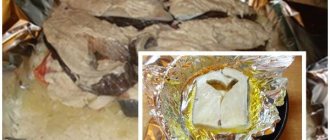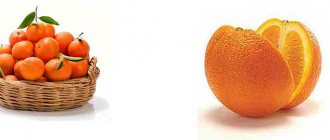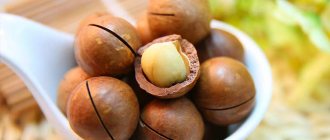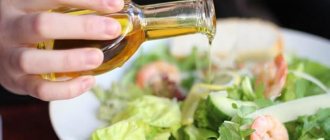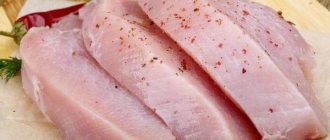© Vladislav Nosik — stock.adobe.com
Share:
An unusual grain, bulgur is crushed wheat grains that have been dried, steamed and stripped of their shells. It has a softer and more pleasant taste compared to other cereals.
Bulgur is a filling and nutritious product. It is not only tasty, but also healthy. The chemical composition of the cereal has a beneficial effect on the body, improving the functioning of all organs and systems. Cereals contain a large amount of fiber, which helps cleanse the intestines of waste and toxins.
Regular consumption of bulgur saturates the body with vitamins and microelements, increases vitality and increases performance. Bulgur porridge is suitable for sports nutrition and provides energy during intense training.
What is bulgur
Bulgur is wheat that has been processed in a special way. First, it is doused with hot steam, dried in the sun, and then cleaned. This processing method allows you to preserve more nutrients.
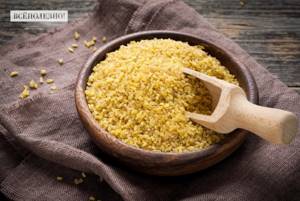
Bulgur is considered a dietary food because it contains a small amount of calories. In terms of its beneficial properties, it even surpasses the much-praised buckwheat. It contains the largest amount of potassium, and vitamins and microelements do not evaporate during heat treatment.
Since the product was pre-treated with steam, all useful elements were noticeable in it.
Where to buy, how to choose correctly, where to store
You can find a new product in the diet, vegetarian or whole grain cereal departments of any supermarket or health food store.
When purchasing, you need to take into account that this cereal comes from India, Turkey and a number of Middle Eastern countries. Bulgur is not produced in Russia!
Give preference to transparent packaging, so the cereal can be assessed by appearance. It should be crumbly, not stick together, without foreign impurities.
The grains themselves are sweetish in taste, with a slight nutty smell, without bitterness, much less mold.
It is better to store cereals in a glass jar under a tight lid, in a cool and dark place for no more than 10 months. Usually the production and expiration dates are indicated on the packaging.
Is it possible to eat bulgur while losing weight?
When losing weight, bulgur is not only something you can eat, but you need to eat it. Even a small portion of the product can satiate a person for quite a long time. The feeling of fullness will not encourage a person to snack. This will have a positive effect on his figure.
To achieve good results in terms of weight loss, you need to remove fats, sugar, confectionery and bakery products from your diet. It is also necessary to exercise. All this will help you lose 2 kilograms of weight in a week. In a month, with the help of bulgur and sports, you can lose up to 10 kilograms. To prevent the weight from returning again, you must continue to adhere to proper nutrition and devote time to physical exercise.
Bulgur for weight loss will be useful only if alcoholic beverages and salty foods are excluded from the diet. Preference should be given to vegetables, fruits and lean meats. You should eat fractionally, up to 5 times a day, and only in small portions. Dinner should be 3 hours before bedtime. You also need to remember about water. The daily norm is 2 liters.
The benefits of cereals
Bulgur helps improve the condition of the upper layers of the skin, accelerate hair growth, and fight dandruff. The product also strengthens bone tissue and the cardiovascular system, and restores metabolism. 100 grams of prepared product contains, as a percentage of the daily value*:
- manganese - 31;
- magnesium - 8;
- copper - 8;
- potassium - 3;
- zinc - 5;
- iron - 5;
- vitamins: PP - 9;
- B5 - 7;
- B6 - 4;
- B1 - 4;
- B9 - 5;
- B2 - 2.
The rich composition of elements and high content of complex carbohydrates determines the wide popularity of cereals among nutritionists.
Properties of bulgur
Bulgur contains a lot of dietary fiber. Once in the body, they swell and act as brushes. Dietary fiber cleanses the intestines, thus improving digestion. Therefore, bulgur is recommended for people with chronic constipation. Another benefit of fiber is that it prevents the formation of cancer in the esophagus and colon.
The elements contained in cereals have a positive effect on the entire body:
- Folic acid. Strengthens the immune system, calms the nervous system, has a beneficial effect on blood vessels and the heart.
- Vitamin B1. Transforms carbohydrates into energy, preventing them from being stored in fat reserves.
- Vitamin B2. Strengthens hair and nails, improves skin condition. Increases hemoglobin in the blood, which prevents the development of anemia.
- Pantothenic acid. Stimulates protein metabolism, absorption of carbohydrates and amino acids. Participates in the production of hormonal substances by the adrenal cortex.
- Minerals. Strengthen the walls of blood vessels, restoring their tone and elasticity. This prevents the development of vascular diseases and normalizes blood circulation.
Bulgur has a beneficial effect on health . The folic acid contained has a positive effect on the reproductive system. It is recommended to eat it after childbirth. It fills the woman’s body with vitamins and minerals, which enter the baby’s body along with milk. Cereals will also help you lose excess weight gained during pregnancy.
Benefit
Since bulgur is loaded with potassium, it should be consumed by people who often experience limb cramps. This mineral eliminates convulsive syndrome.
For diabetes
This product a low hypoglycemic index. After eating porridge, blood sugar does not rise and insulin is not released. Therefore, people with type 1 and type 2 diabetes can consume bulgur.
For pancreatitis
Bulgur has a positive effect on the entire body. It improves the functioning of the intestines and normalizes the production of digestive enzymes. The only thing is that bulgur is prohibited for acute pancreatitis. Fiber irritates the mucous membrane, which leads to exacerbation of inflammation and spasms of the pancreatic ducts. This will lead to nausea, flatulence and intestinal colic.
For chronic pancreatitis, bulgur is consumed outside the acute stage. The acceptable norm per day will be 150-200 grams. For pancreatitis, only boiled product is allowed. It will restore energy reserves and nourish you with useful substances.
For gastritis
For gastritis, all types of porridges are allowed. If there is high acidity, bulgur can be consumed 1-2 times a week. You should give up cereals only during the period of exacerbation of the disease. During this period, any porridge can be harmful. It has a strong mechanical effect on the mucous membrane.
For gastritis, you can eat bulgur cooked in water. During the period of stable remission, it is allowed to cook it with milk. The prepared porridge must be ground in a blender or rubbed through a sieve so that it acquires a viscous consistency. It should only be consumed warm. Hot and cold food can injure inflamed mucous membranes.
Important! Whether or not to include bulgur in your diet can only be determined by your doctor.
For cholecystitis
If you have cholecystitis, you should not limit yourself to consuming such a healthy product as bulgur. It can be eaten in the form of soups or milk porridges. The only thing is that you should not add oil or spices to them.
Possible harm and contraindications
Bulgur contains large amounts of gluten and gluten. The latter is a plant protein that can cause an allergic reaction. For this reason, cereals should not be consumed by people with gluten and grain intolerance or gastrointestinal diseases.
Bulgur, like wheat, contains a large amount of fiber. It improves intestinal motility and promotes weight loss. But if there are malfunctions of the pancreas, liver or stomach, its use causes bloating, pain and stool disorders.
These same symptoms may appear in pregnant women in the third trimester. Therefore, during this period and in the first month of lactation, you should refrain from eating bulgur.
General characteristics and manufacturing technology
Content:
- General characteristics and manufacturing technology
- Types of bulgur
- Calorie content and chemical composition
- Useful properties of cereals
- Use in cooking
- Herbs and spices
- What goes with it?
- What can be substituted in recipes?
- How to select and store
- Harm and contraindications
- Use in cosmetology
In fact, bulgur is not some mysterious cereal crop, but ordinary wheat. There is, however, one important “but”: to prepare bulgur, only grain that was collected during the period of milk maturity is used. Briefly, the process of making this cereal can be described as follows: the grain is dried, cleared of bran, steamed, and then crushed. The result is something resembling fairly coarsely ground corn grits.
In fact, the process of preparing bulgur is labor-intensive and consists of many steps.
Thus, in rural areas in the Middle East, they begin to harvest bulgur in the summer. The grain is carefully sorted and cleaned, after which it is boiled in huge vats, mixing thoroughly. When the wheat becomes soft, it is dried by spreading it on a clean surface in a thin layer. As a rule, drying continues for three days, and the grain is mixed twice a day. As a result of such drying, boiled wheat decreases in size.
The next stage is peeling. The grain is moistened again, after which it is placed in stone mortars and begins to be beaten using wooden hammers. Then the future cereal is again sent for drying, as a result of which the bran is separated. It is believed that it is at this stage of processing that bulgur acquires its nutty flavor.
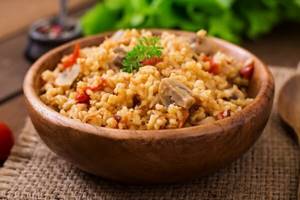
The final stage is grinding the cereal. As a rule, hand mills are used for this. After grinding, the product is divided into three fractions using sieves, depending on the size of the particles. It is noteworthy that finely, medium and coarsely ground bulgur tastes significantly different, and it is used to prepare different dishes.
Of course, industrial production of bulgur differs from “handicraft” production, but the essence remains the same. The grain is first saturated with moisture for a long time, then subjected to steam treatment, and at the final stage it is dried, crushed and divided into fractions.
Ready-made bulgur has a distinct nutty aroma, as well as a very pleasant, original and piquant taste, which does not need to be emphasized with additional spices or sauces. In addition, this porridge is incredibly nutritious.
Cooking methods for weight loss
In the East, bulgur is first fried, and only then a little water is added and simmered over low heat. If you want to get a more dietary product, then the cereal should be washed, added with water and cooked for half an hour. If small bulgur is used, its cooking time takes 4 minutes.
To preserve the greatest amount of nutrients in the cereal, it is recommended to steam it. In this case, the bulgur is washed and poured with boiling water. It can be eaten after 10-12 hours.
To prepare dietary pilaf, you need to use bulgur and chicken breast instead of pork and rice. Onions and carrots will help increase the volume of the dish.
Bulgur has a pleasant nutty taste, so it can be added to various salads. They should be seasoned with olive or linseed oil. The latter is especially useful, as it contains a large amount of polyunsaturated fatty acids. They are similar in composition to red fish fats.
Porridge can be consumed both for breakfast and lunchtime. Dinner should be three hours before bedtime.
Soup with bulgur and lentils
To prepare this dish you will need:
- 100 grams of bulgur;
- 100 grams of lentils;
- bulb;
- carrot;
- Bell pepper;
- 400 grams of fresh tomatoes;
- 60 grams of vegetable oil.
In a small saucepan you need to add 2.5 liters of water. It can be replaced with ready-made low-fat chicken broth. When the liquid boils, pour the cereal into it. They should be cooked for about 20 minutes.
Pour oil into a frying pan and add diced onions and carrots. When they acquire a golden color, add finely chopped tomatoes. All vegetables are stewed for about 15 minutes. They are poured into soup and salted. If desired, you can add a little sugar. You should not use spices; it is better to add cilantro or any other pleasant herbs. Turn off the heat and leave the soup for a while until it develops its flavor.
Beats
This recipe is suitable for people who prefer lean meat and want to diversify their diet. To prepare the meatballs, you need to take:
- 180 grams of boiled bulgur;
- 35 grams of feta cheese;
- 25 grams of canned peas;
- egg;
- zucchini;
- Bell pepper;
- greenery;
- vegetable oil;
- pickled crackers.
This amount of food is enough to prepare 10 meatballs. The calorie content of one cutlet is approximately 70 kcal.
Before cooking, the bulgur is soaked in cold water for several hours. Afterwards it is cooked like regular porridge.
In a large container, mix boiled bulgur, green peas, cheese, herbs and egg. All products are thoroughly kneaded with a fork. Grate the zucchini and pepper on a fine grater. The resulting mixture is added to the remaining ingredients. Everything is carefully poured and salted.
The minced meat is formed into balls and sprinkled with breadcrumbs. Fry in vegetable oil until golden brown.
Advice! If the minced meat turns out crumbly and does not hold its shape well, you should add a little breadcrumbs to it.
Salad
This salad turns out to be satisfying and healthy. It includes:
- 180 grams of boiled bulgur;
- cucumber;
- 3 ripe tomatoes;
- lemon;
- lettuce leaves;
- mint.
The greens are washed under running water and finely chopped with a knife. Vegetables are cut into small cubes. Pour porridge, herbs and vegetables into a salad bowl, add the juice of one lemon, and salt to taste.
100 grams of product contains no more than 90 kcal, so the salad can be consumed regularly. It is even suitable for mono-diets.
Pate
Pate is usually not classified as a dietary product, but if it is made from bulgur, it will turn out light and tasty. To prepare it, you need to take:
- a glass of red beans;
- 3 glasses of water;
- half a glass of bulgur cereal;
- a couple of cloves of garlic;
- greenery;
- vegetable oil;
- yogurt or kefir with minimal fat content.
The beans are soaked in water at room temperature for 10 hours. Afterwards it is simmered over low heat until cooked. Ready beans are salted.
Pour boiling water over the bulgur and leave it aside for a while to allow the grain to swell. Finely chop the onion and garlic and fry in vegetable oil until transparent. Grind the beans in a blender or mash thoroughly with a fork until smooth. Add onion, garlic, bulgur and yogurt to it. All ingredients are then ground in a blender until smooth. Finely chopped herbs and lemon juice are added to the finished pate.
Stuffed eggplants
This dish can even decorate a holiday table. It includes :
- 2 young eggplants;
- 50 grams of bulgur;
- 5 champignons;
- tomato;
- bulb;
- a couple of cloves of garlic;
- spices;
- vegetable oil.
Bulgur should be boiled or steamed with boiling water. In this case, both methods of preparing cereal are suitable. The onion is cut into small cubes and fried in vegetable oil until golden brown. Mushrooms cut into thin slices are poured into the onion. They are fried for another 5 minutes. The tomatoes are peeled, cut into cubes and added to the mushrooms. Add salt, spices, garlic and simmer for a few more minutes.
Pour bulgur and basil into the cooked vegetables, mix everything thoroughly, turn off the heat. Cover the pan with a lid and leave for a few minutes so that all the ingredients are saturated with juice.
Eggplants are washed and cut in half. Using a tablespoon, make a small indentation in them. It is greased with oil and the prepared minced meat is added. The prepared eggplants are placed in a baking container. To prevent their tails from burning, they are wrapped in foil.
Vegetables should be baked at +180°C for 10 minutes.
Advice! To prevent the filling from burning, it must be greased with vegetable oil.
Short story
To this day, such valuable cereal remains unknown to the residents of our country, but citizens of the eastern countries of the world - China, India and others - have known about the existence of wheat processed in a special way for almost three thousand years.
The first mentions in historical sources date back to the ninth century BC. For centuries, the product has been present on the tables of residents of the following countries:
- China;
- Türkiye;
- Iran;
- Italy;
- India and many others.
In our country, cereals first began to appear only at the beginning of the last century, so many are interested in the properties of the product under the specified trade name.
Is the product recommended for PP
People lead different lifestyles and have or do not have contraindications to various products. You need to compare their benefits and harm to your body, and if you have any doubts, ask your doctor for advice.
If a person does not suffer from celiac disease, then bulgur is undoubtedly a healthy product for him. Only those who suffer from digestive system disorders should eat it in very small quantities.
For everyone else, nutrition experts give a positive answer to the question of whether it is possible to eat bulgur on PP. This is a nutritious and dietary product that is indicated for athletes, those losing weight, and even those who have metabolic disorders.
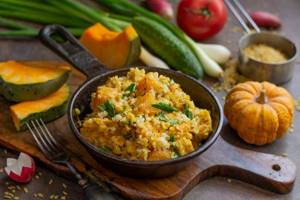
Bulgur with pumpkin and celery
What goes with it?
Bulgur is an amazing grain because it can be combined with almost any ingredient: vegetables, fish and meat, as well as fruits.
Most often, this cereal is used to prepare porridge. It can be made not only salty, but also sweet. The nutty taste of bulgur is perfectly complemented by dried fruits, such as dried apricots, dried pineapples or raisins.
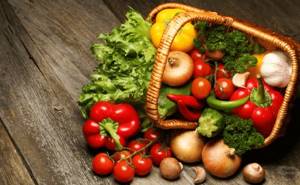
Fresh vegetables also go well with this product. Fresh mint will add a special piquancy to a salad of greens and bulgur.
However, most often bulgur is used as a side dish for meat. In the East, it is customary to serve it with pork to neutralize the fat content of this product. Pork is often baked in the oven along with bulgur so that the cereal is saturated with meat juice.
Daily norm
Cereal, even for its beneficial properties, should not be consumed in large quantities on a daily basis. In this case, its benefits will be canceled out by its high calorie content, turning into harm. During the diet, bulgur alternates with a large amount of fruits and vegetables, the daily norm is 50–75 g. In other cases, the consumption of crushed wheat can increase to 100 g per day.
When determining the individual daily intake based on the characteristics of the body, you need to take into account the significant gluten content in bulgur. For some people, plant protein is a powerful allergen, so to avoid unpleasant consequences, you need to study the reaction to such food. The possible presence of an allergy is indicated by such signals as sudden diarrhea, flatulence, and poor health.
